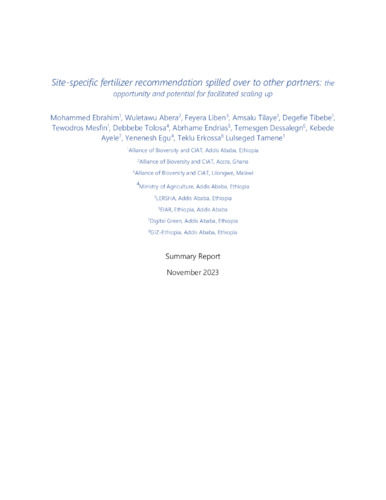Site-specific fertilizer recommendation spilled over to other partners: The opportunity and potential for facilitated scaling up
Over the last decades, the government of Ethiopia has taken several measures to achieve food security for its population. However, crop production is still below the optimal possible. Studies show that wheat, maize, and sorghum yields in Ethiopia are about 26.8, 19.7, and 29.3 % of their water-limited yield potentials. Some legumes such as common bean even experience higher yield gap of 35.5%. These indicate the potential for increasing productivity of crops in the country through addressing the key bottlenecks. Several factors play important role in determining crop yields in the country. Genetic varieties, agronomic practices, climate variability, soil fertility, and limited or lack of input use are the major once. Evidences show that the lack of a context-specific and evidence-based advisory system that enables targeted application of the right amount and type of input at the right place and right time play pivotal role in undermining the productivity of major crops in Ethiopia. The Alliance of Bioversity and CIAT in collaboration with different partners has been engaged to develop ‘site-specific’ fertilizer recommendation for wheat, maize, barley, and teff. The project was mainly implemented through the support of the Supporting Soil Health Initiative (SSHI) of GIZ-Ethiopia, the Excellence in Agronomy (EiA) CGIAR Initiative, and the Accelerating the Impacts of CGIAR Climate Research in Africa (AICCRA). The engagement was structured so that the research organizations could produce advisory content to meet the demands of development organizations and other actors, including Digital Green. The generated advisory content was then communicated to extension workers and farmers by Digital Green through agile dissemination channels. Validation and piloting results of the site-specific recommendations for wheat showed very encouraging results in terms of both yield and water and nutrient efficiency. Validation and piloting results of the site-specific recommendation for wheat showed very encouraging results in terms of both yield, water, and nutrient efficiencies. This success story has attracted the attention of other actors (government organizations and private sector) to pilot the advisory. This report outlines the processes of the piloting exercises and the number of farmers reached through the ‘new partners’ that have been attracted by the achievement with Digital Green.

